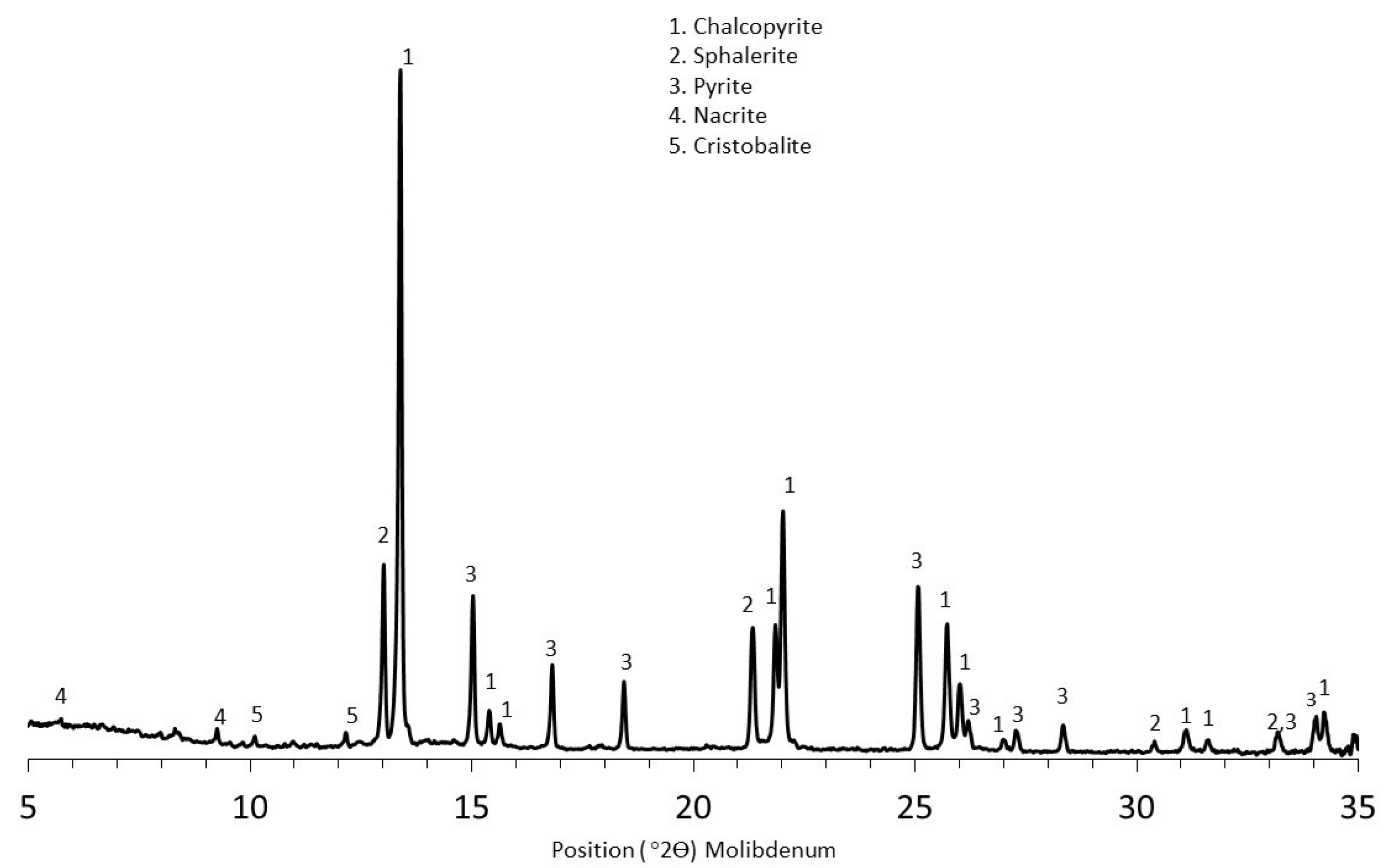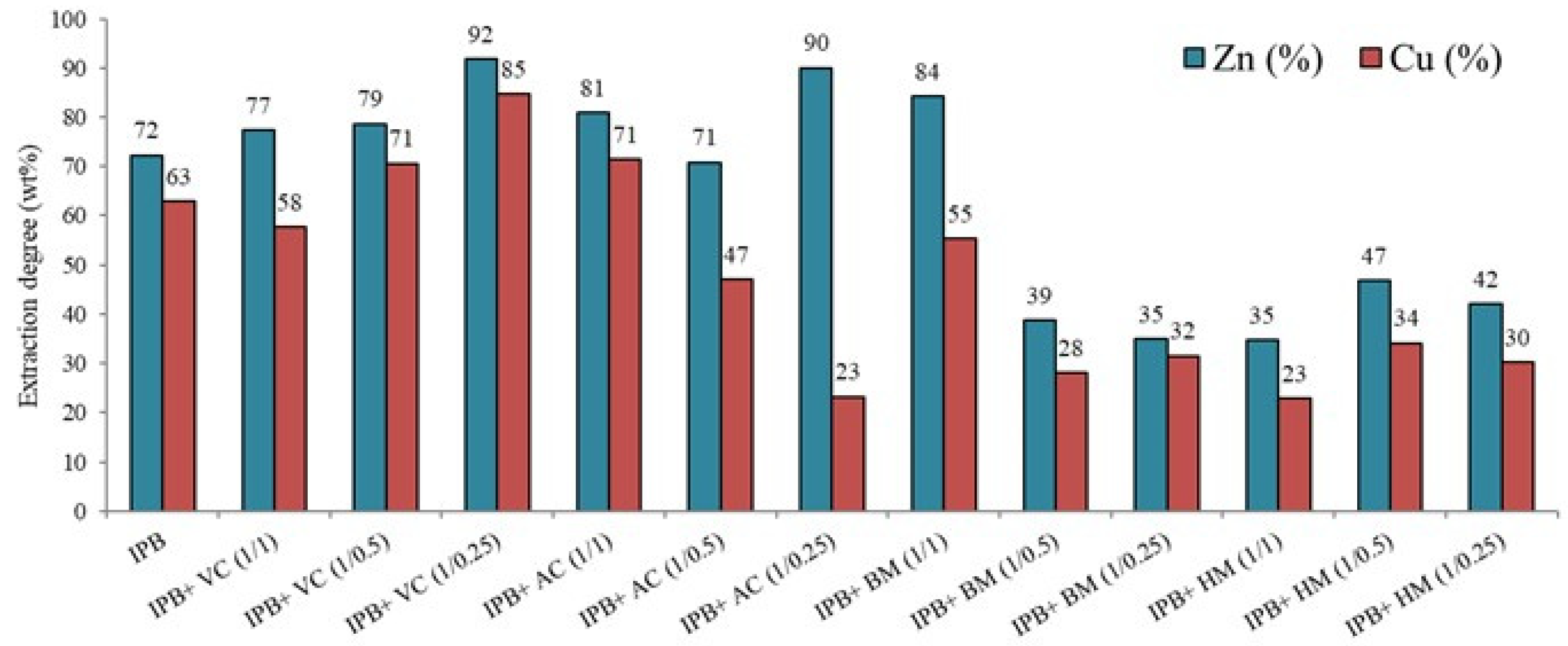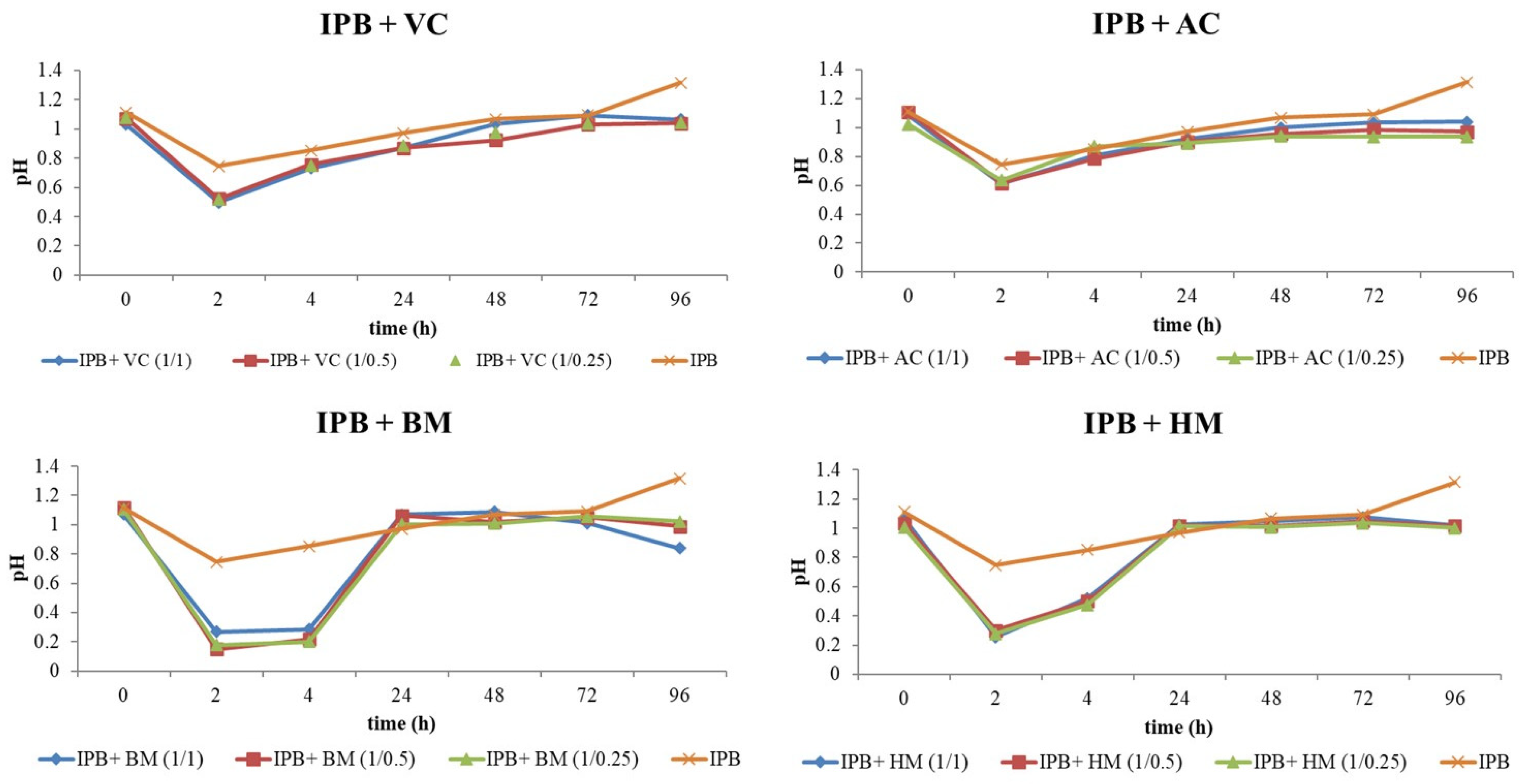Hydrometallurgical Recovery of Cu and Zn from a Complex Sulfide Mineral by Fe3+/H2SO4 Leaching in the Presence of Carbon-Based Materials
Abstract
1. Introduction
2. Materials and Methods
2.1. Materials Selection and Characterization
2.2. Leaching Experiments
3. Results and Discussion
3.1. Characteristics of Samples
3.2. Extraction Degree of Cu and Zn
3.3. Eh Evolution during Leaching Experiments
3.4. pH Evolution during Leaching Experiments
4. Conclusions
Author Contributions
Funding
Institutional Review Board Statement
Informed Consent Statement
Conflicts of Interest
References
- Baba, A.A.; Ayinla, K.I.; Adekola, F.A.; Ghosh, M.K.; Ayanda, O.S.; Bale, R.B.; Sheik, A.R.; Pradhan, S.R. A review on novel techniques for chalcopyrite ore processing. Int. J. Min. Eng. Miner. Process. 2012, 1, 1–16. [Google Scholar] [CrossRef]
- Wang, S. Copper leaching from chalcopyrite concentrates. JOM 2005, 57, 48–51. [Google Scholar] [CrossRef]
- Watling, H.R. The bioleaching of sulphide minerals with emphasis on copper sulphides: A review. Hydrometallurgy 2006, 84, 81–108. [Google Scholar] [CrossRef]
- Karimov, K.A.; Rogozhnikov, D.A.; Kuzas, E.A.; Shoppert, A.A. Leaching kinetics of arsenic sulfide-containing materials by copper sulfate solution. Metals 2020, 10, 7. [Google Scholar] [CrossRef]
- Chagnes, A. Advances in hydrometallurgy. Metals 2020, 9, 211. [Google Scholar] [CrossRef]
- Cortés, S.; Soto, E.E.; Ordóñez, J.I. Recovery of Copper from Leached Tailing Solutions by Biosorption. Minerals 2020, 10, 158. [Google Scholar] [CrossRef]
- Jorjani, E.; Ghahreman, A. Challenges with elemental sulfur removal during the leaching of copper and zinc sulfides and from the residues: A review. Hydrometallurgy 2017, 171, 333–343. [Google Scholar] [CrossRef]
- Watling, H.R. Chalcopyrite hydrometallurgy at atmospheric pressure: 1. Review of acidic sulfate, sulfate–chloride and sulfate–nitrate process options. Hydrometallurgy 2013, 140, 163–180. [Google Scholar] [CrossRef]
- Lorenzo-Tallafigo, J.; Romero-García, A.; Iglesias-Gonzalez, N.; Mazuelos, A.; Romero, R.; Carranza, F. A novel hydrometallurgical treatment for the recovery of copper, zinc, lead and silver from bulk concentrates. Hydrometallurgy 2020, 200, 105548. [Google Scholar] [CrossRef]
- Hackl, R.P.; Peters, E.; King, J.A. Passivation of chalcopyrite during oxidative leaching in sulfate media. HydrometaIlurgy 1995, 39, 25–48. [Google Scholar] [CrossRef]
- Li, Y.; Kawashima, N.; Li, J.; Chandra, A.P.; Gerson, A.R. A review of the structure, and fundamental mechanisms and kinetics of the leaching of chalcopyrite. Adv. Colloid Interface Sci. 2013, 197–198, 1–32. [Google Scholar] [CrossRef]
- Nourmohamadi, H.; Esrafili, M.D.; Aghazadeh, V. DFT study of ferric ion interaction with passive layer on chalcopyrite surface: Elemental sulfur, defective sulfur and replacement of M2+(M=Cu and Fe) ions. Comput. Condens. Matter 2021, 26, e00536. [Google Scholar] [CrossRef]
- Munoz, P.B.; Miller, J.D.; Wadsworth, M.E. Reaction mechanism for the acid ferric sulfate leaching of chalcopyrite. Metall. Mater. Trans. B 1979, 10, 149–158. [Google Scholar] [CrossRef]
- Nakazawa, H. Effect of carbon black on chalcopyrite leaching in sulfuric acid media at 50 ºC. Hydrometallurgy 2018, 177, 100–108. [Google Scholar] [CrossRef]
- Castellón, C.I.; Hernández, P.C.; Velásquez-Yévenes, L.; Taboada, M.E. An alternative process for leaching chalcopyrite concentrate in nitrate-acid-seawater media with oxidant recovery. Metals 2020, 10, 518. [Google Scholar] [CrossRef]
- Hernández, P.; Gahona, G.; Martínez, M.; Toro, N.; Castillo, J. Caliche and seawater, sources of nitrate and chloride ions to chalcopyrite leaching in acid media. Metals 2020, 10, 551. [Google Scholar] [CrossRef]
- Castillo-Magallanes, N.; Cruz, R.; Lázaro, I. Effect of organic agents on the oxidation process of chalcopyrite in a sulfuric acid solution. Electrochim. Acta 2020, 335, 136789. [Google Scholar] [CrossRef]
- Tehrani, M.E.H.N.; Naderi, H.; Rashchi, F. Electrochemical study and XPS analysis of chalcopyrite dissolution in sulfuric acid in the presence of ethylene glycol. Electrochim. Acta 2021, 369, 137663. [Google Scholar] [CrossRef]
- Kartal, M.; Xia, F.; Ralph, D.; Rickard, W.D.A.; Renard, F.; Li, W. Hydrometallurgy Enhancing chalcopyrite leaching by tetrachloroethylene-assisted removal of sulphur passivation and the mechanism of jarosite formation. Hydrometallurgy 2020, 191, 105–192. [Google Scholar] [CrossRef]
- Dixon, D.G.; Mayne, D.D.; Baxter, K.G.; Galvanox, T.M. A novel galvanically-assisted atmospheric leaching technology for copper concentrates. Can. Metall. Q. 2008, 47, 327–336. [Google Scholar] [CrossRef]
- Sanchez, E.C.; Umetsu, Y.; Saito, F. Effect of iron powder on copper extraction by acid leaching of chalcopyrite concentrate. J. Chem. Eng. Jpn. 1996, 29, 720–722. [Google Scholar] [CrossRef][Green Version]
- Misra, M.; Fuerstenau, M.C. Chalcopyrite leaching at moderate temperature and ambient pressure in the presence of nanosize silica. Miner. Eng. 2005, 18, 293–297. [Google Scholar] [CrossRef]
- Okamoto, H.; Nakayama, R.; Kuroiwa, S.; Hiroyoshi, N.; Tsunekawa, M. Catalytic effect of activated carbon and coal on chalcopyrite leaching in sulfuric acid solutions. Shigen Sozai 2004, 120, 600–606. [Google Scholar] [CrossRef][Green Version]
- Nakazawa, H.; Nakamura, S.; Odashima, S.; Hareyama, W. Effect of carbon black to facilitate galvanic leaching of copper from chalcopyrite in the presence of manganese (IV) oxide. Hydrometallurgy 2016, 163, 69–76. [Google Scholar] [CrossRef]
- Medina, D.; Anderson, K.G. A review of the cyanidation treatment of copper-gold ores and concentrates. Metals 2020, 10, 897. [Google Scholar] [CrossRef]
- Yuan, Y.; Bolan, N.; Prévoteau, A.; Vithanage, M.; Kumar, J.; Sik, Y.; Wang, H. Applications of biochar in redox-mediated reactions. Bioresour. Technol. 2017, 246, 271–281. [Google Scholar] [CrossRef] [PubMed]
- Álvarez, M.L.; Gascó, G.; Palacios, T.; Paz-Ferreiro, J.; Méndez, A. Fe oxides-biochar composites produced by hydrothermal carbonization and pyrolysis of biomass waste. J. Anal. Appl. Pyrolysis 2020, 151, 104893. [Google Scholar] [CrossRef]
- Crdoba, E.M.; Munoz, J.A.; Blázquez, M.L.; González, F.; Ballester, A. Leaching of chalcopyrite with ferric ion. Part II: Effect of redox potential. Hydrometallurgy 2008, 93, 88–96. [Google Scholar] [CrossRef]
- Hiroyoshi, N.; Kitayawa, H.; Tsunekawa, M. Effect of solution composition on the optimum redox potential for chalcopyrite leaching in sulfuric acid solutions. Hydrometallurgy 2008, 91, 144–149. [Google Scholar] [CrossRef]
- Hiroyoshi, N.; Miki, H.; Hirajima, T.; Tsunekawa, M. A model for ferrous-promoted chalcopyrite leaching. Hydrometallurgy 2000, 57, 31–38. [Google Scholar] [CrossRef]
- Kametani, H.; Aoki, A. Effect of suspension potential on the oxidation rate of copper concentrate in a sulfuric acid solution. Metall. Trans. B 1985, 16, 695–705. [Google Scholar] [CrossRef]
- Córdoba, E.M.; Muñoz, J.A.; Blázquez, M.L.; González, F.; Ballester, A. Passivation of chalcopyrite during its chemical leaching with ferric ion at 68 ºC. Miner. Eng. 2009, 22, 229–235. [Google Scholar] [CrossRef]






| Sample | C (%) | H (%) | N (%) | S (%) | O (%) | H/C | O/C | Ash (%) | pH | Eh (mV) | SBET (m2/g) |
|---|---|---|---|---|---|---|---|---|---|---|---|
| CA | 85.72 | 0.88 | 0.00 | 0.00 | 13.41 | 0.12 | 0.12 | 1.00 | 8.03 | 453 | 1138.96 |
| CV | 80.21 | 3.12 | 0.92 | 0.00 | 15.74 | 0.47 | 0.15 | 14.94 | 8.31 | 355 | 2.18 |
| BM | 20.18 | 0.29 | 0.60 | 7.83 | 0.71 | 0.17 | 0.03 | 70.38 | 7.33 | 314 | 56.86 |
| HM | 43.81 | 0.81 | 1.14 | 5.12 | 8.14 | 0.22 | 0.14 | 40.98 | 8.22 | 298 | 183.63 |
| Mineral | Content (%) |
|---|---|
| Chalcopyrite (CuFeS2) | 52.6 ± 0.9 |
| Sphalerite (ZnS) | 32.2 ± 0.2 |
| Pyrite (FeS2) | 8.4 ± 0.6 |
| Nacrite (Al2Si2O5(OH)4) | 5.1 ± 0.1 |
| Cristobalite (SiO2) | 1.4 ± 0.4 |
| Element | Content (%) |
|---|---|
| Fe | 20.68 ± 0.16 |
| Cu | 17.61 ± 0.17 |
| S | 13.36 ± 0.17 |
| Zn | 6.76 ± 0.11 |
| Si | 1.67 ± 0.05 |
| Al | 0.664 ± 0.03 |
| Mg | 0.413 ± 0.021 |
| Sb | 0.229 ± 0.011 |
| As | 0.123 ± 0.062 |
| Ca | 0.115 ± 0.006 |
| Co | 0.0702 ± 0.0035 |
| Ti | 0.0329 ± 0.0016 |
| Pb | 0.0402 ± 0.0020 |
| K | 0.0240 ± 0.0012 |
| P | 0.0125 ± 0.0016 |
| Mn | 0.0212 ± 0.0011 |
| Se | 0.0149 ± 0.008 |
| Sn | 0.0116 ± 0.0014 |
| Cd | 0.0093 ± 0.0013 |
Publisher’s Note: MDPI stays neutral with regard to jurisdictional claims in published maps and institutional affiliations. |
© 2021 by the authors. Licensee MDPI, Basel, Switzerland. This article is an open access article distributed under the terms and conditions of the Creative Commons Attribution (CC BY) license (http://creativecommons.org/licenses/by/4.0/).
Share and Cite
Álvarez, M.L.; Fidalgo, J.M.; Gascó, G.; Méndez, A. Hydrometallurgical Recovery of Cu and Zn from a Complex Sulfide Mineral by Fe3+/H2SO4 Leaching in the Presence of Carbon-Based Materials. Metals 2021, 11, 286. https://doi.org/10.3390/met11020286
Álvarez ML, Fidalgo JM, Gascó G, Méndez A. Hydrometallurgical Recovery of Cu and Zn from a Complex Sulfide Mineral by Fe3+/H2SO4 Leaching in the Presence of Carbon-Based Materials. Metals. 2021; 11(2):286. https://doi.org/10.3390/met11020286
Chicago/Turabian StyleÁlvarez, María Luisa, José Manuel Fidalgo, Gabriel Gascó, and Ana Méndez. 2021. "Hydrometallurgical Recovery of Cu and Zn from a Complex Sulfide Mineral by Fe3+/H2SO4 Leaching in the Presence of Carbon-Based Materials" Metals 11, no. 2: 286. https://doi.org/10.3390/met11020286
APA StyleÁlvarez, M. L., Fidalgo, J. M., Gascó, G., & Méndez, A. (2021). Hydrometallurgical Recovery of Cu and Zn from a Complex Sulfide Mineral by Fe3+/H2SO4 Leaching in the Presence of Carbon-Based Materials. Metals, 11(2), 286. https://doi.org/10.3390/met11020286








